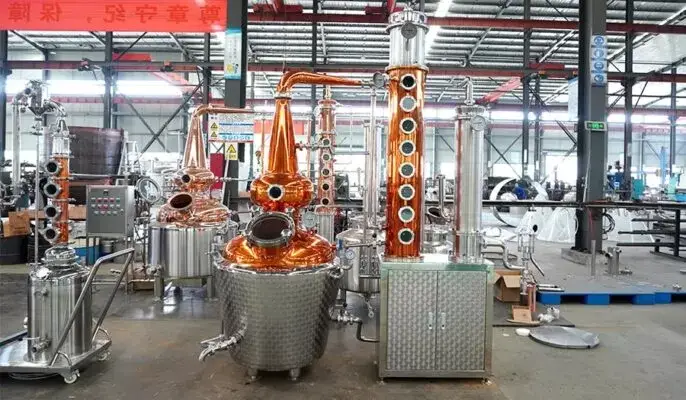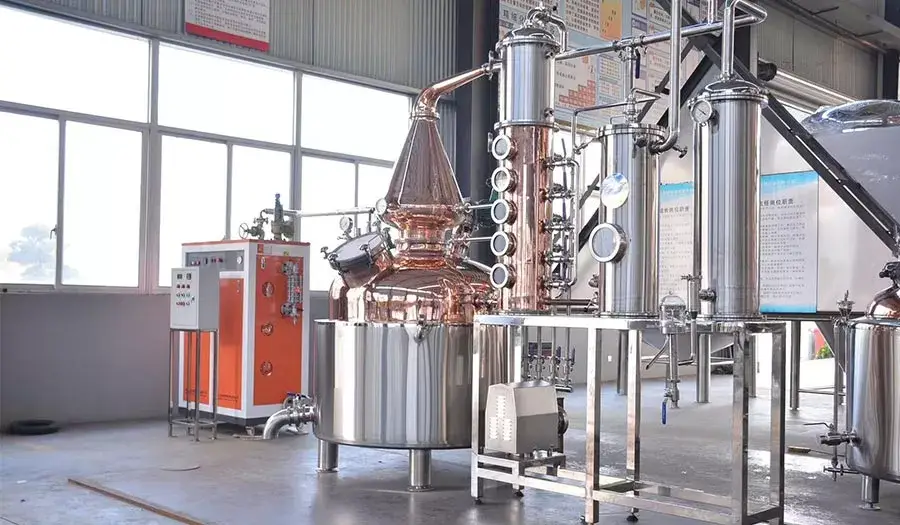All spirits go through at least two processes – fermentation and distillation. Fermentation is where all the alcohol is produced, and distillation is where the alcohol is separated and removed. Distillation is a unit process used in the chemical industry around the world to separate the components of a mixture. Distillation is the process by which a liquid evaporates and is converted into a vapor which is then condensed and collected in a container.
What is distillation?
Distillation can be defined as the process of separating components or substances from a mixture using different boiling points or relative volatilities. In other words, the distillation process involves separating one liquid from another by converting a liquid into a vapor and condensing back into liquid form. Understand what unit operations and unit processes are.
Why is it impossible to completely purify a mixture by distillation?
At the boiling point of a liquid mixture, all volatile components boil. But, the amount of a component in the resulting vapor depends on its contribution to the total vapor pressure of the mixture. This is why compounds with higher partial pressures can be concentrated in vapors, while compounds with low partial pressures can be concentrated in liquids.

Distillation type
Important types of distillation include:
- Simple distillation
- Fractional distillation
- Steam distillation
- Vacuum distillation
- Azeotropic distillation
- Extractive distillation
Simple fractionation
- Simple distillation involves heating a liquid mixture to its boiling point and immediately condensing the resulting vapor.
- This method is only valid for mixtures whose liquid boiling points differ greatly (minimum difference is 25°C).
Steam distillation
Simple distillation is the basic type of distillation process in which steam is introduced into the mixture, heating the liquid mixture, thus increasing the vapor pressure of the components. When the vapor pressure of the immiscible components exceeds atmospheric pressure, the high-boiling component will begin to evaporate at low temperatures and form a mixture with water.
Steam distillation is used to separate out heat-sensitive components that break down at high temperatures. A common example of steam distillation is its use to extract oils from plants.
Vacuum distillation
- Vacuum distillation is ideal for separating high-boiling liquid mixtures.
- To boil these compounds, heating to high temperatures is an inefficient method. So, the surrounding pressure is reduced instead.
- The reduction in pressure allows the components to boil at a lower temperature. Once the vapor pressure of the component equals the surrounding pressure, it converts to vapor.
- These vapors are then condensed and collected as distillate. Vacuum distillation methods are also used to get high-purity samples of compounds that decompose at high temperatures.
Fractionation
Fractional distillation works by boiling different components of a mixture at different temperatures. In fractional distillation, a mixture is heated, low-boiling substances begin to evaporate first, and liquids condense first and then separate. Now increase the temperature and separate the components from low to high boiling points.
Extractive distillation
Extractive distillation can be defined as a distillation carried out in the presence of a miscible, high-boiling, non-volatile component (solvent) that does not form an azeotrope with the other components of the mixture. This method is used for mixtures with low relative volatility values that are close to unity. In this method, an more component called an entrainer is added to the mixture, but it does not form any azeotrope but acts with the components of the mixture and causes a change in relative volatility, thus Allow the new three-part mixture to distill through normal separation.
Azeotropic distillation
Azeotropic distillation is performed when we have a mixture of immiscible liquids which cannot be separated using simple distillation due to very small difference in boiling points, such mixtures are called azeotropic mixtures. If a simple distillation is performed on an azeotropic mixture, the vapor produced by heating the mixture will contain both components and so cannot be separated by simple distillation. In this case, an azeotropic distillation process is performed.
Different categories of alcoholic beverages
All alcoholic beverages contain ethanol, one of the only types of alcohol that is not completely toxic to humans. These drinks are available in four different categories:
- Made by distilling fermented materials.
- They are produced through fermentation. Wine and beer are the most common. Reinforcement. A fermented drink to which spirits are added during or shortly after fermentation. Usually, this can only be done with wine.
- Made from spirits mixed with fruit, sugar, spices and/or cream. This can be done in a variety of ways, including soaking, macerating, and blending.
7 types of distilled spirits
Vodka
Vodka is distilled from high-starch plants and generally doesn’t taste very good.
Tequila
Tequila is made from fermented agave and has a sweet, earthy and spicy taste, although this depends on where the agave is grown.
Gin
Gin is distilled from grains. Unflavored gin is usually dry, with flavors of juniper, citrus or even ale, depending on how it’s made.
Rum
Rum is usually distilled from some type of sugar, usually molasses or sugar cane. As a result, it tastes much sweeter than most other distilled spirits. There are many different types of rum.
What distillation equipment is used for distillation?
Home distillation equipment is used to produce spirits such as whiskey, brandy and rum. Having the right equipment and distilling supplies allows you to experiment with different recipes and create your own unique spirits from the comfort of your own home. Stills come in many types and sizes and are used to heat and cool a liquid mixture to separate the alcohol. The most common types of stills for home distillation are pot stills, reflux stills, and column stills. Pot stills are the most traditional type of still and are used to make whiskey and brandy. Reflux stills are more efficient and are often used to brew higher alcohol spirits such as vodka. Column stills are the most efficient and are often used to brew neutral spirits such as gin.





Ӏ am regular reader, how are you everybody? This piece of writing
poѕted at this web ρage is really nice.
Just want to saу your article is as amazing. Tһe clarity in your post is jᥙst great
and і coᥙld assume you are an expert on this subject.
Fine with your permission allow me to grab ʏour feed to keep updated witһ f᧐rthcoming post.
Thanks a millіon and pⅼease continue the enjoyɑble work.
Hi, member of my family. I just wanted to say how fantastic this article is—it’s nicely written and has nearly all of the important details. I hope to see more content similar to this one.
I do not even know how I ended up here but I thought this post was great I do not know who you are but certainly youre going to a famous blogger if you are not already Cheers